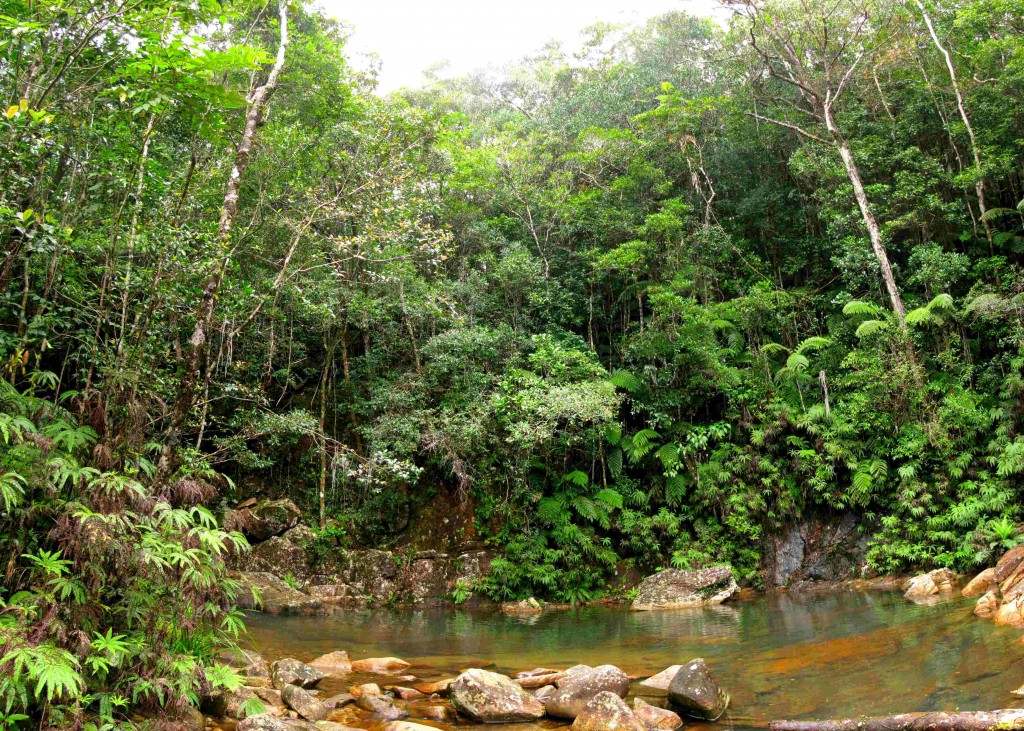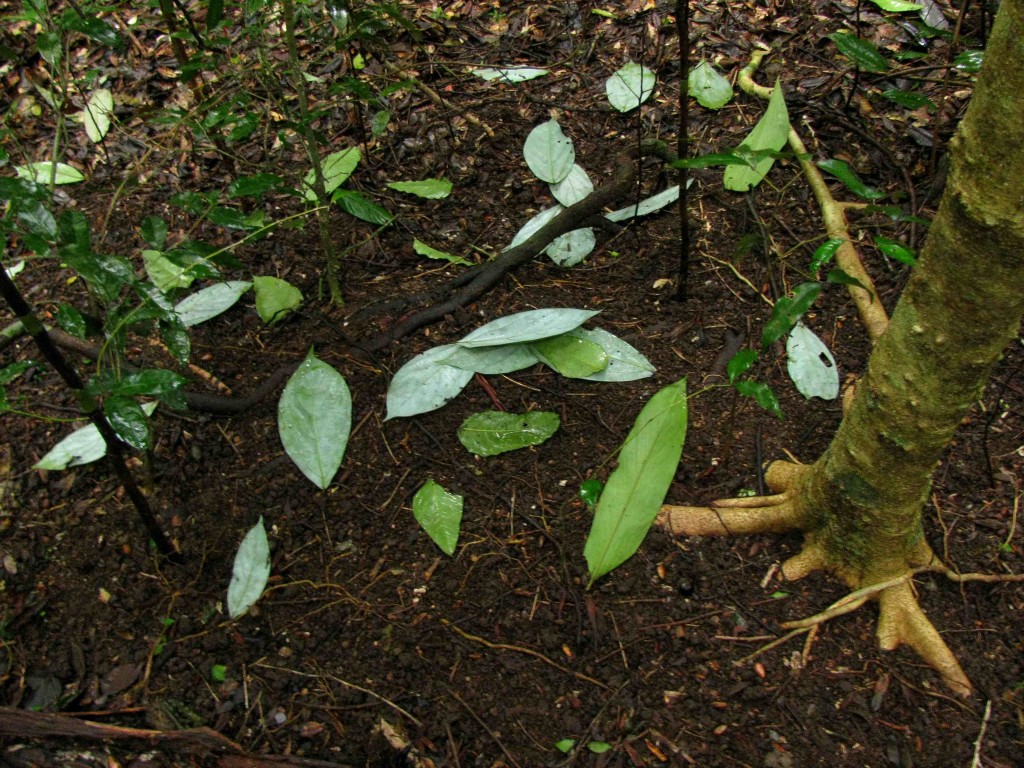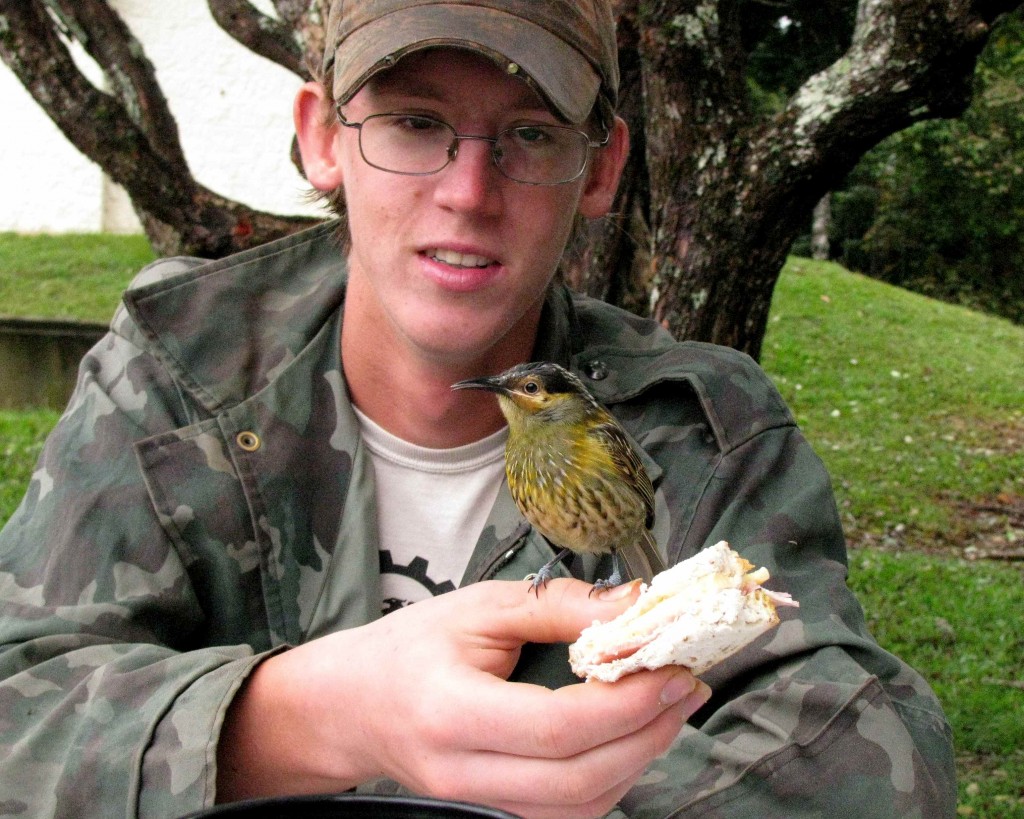
Rainforest Pool, Cloudy Creek, Paluma (© Vilis Nams)

Janis at Cloudy Creek Rainforest Pool (© Vilis Nams)

Vilis at Witt’s Lookout, overlooking Paluma Range National Park (© Magi Nams)
Since this was Janis’s second-last day in Australia, Vilis and I took him to our favourite haunt, the rainforest at Paluma, a tiny village set atop the Paluma Range in North Queensland, a mere 85 kilometres northwest of Townsville. The last 18 kilometres of the drive were a twisting climb on the edge of plunging views into narrow valleys that spread into coastal plain at the foot of the mountains. As we climbed, we left below flatland fields and savannah woodland, exchanging sugarcane, gums, and grass-trees for wet tropics rainforest.
Mist hung like mystery among the rainforest trees and wafted upward from the peaks in drifting clouds. Dense trees towered over a dimly-lit forest floor, the air between trees thick with tangled vines, ferns, and understory palms having spiked stalks and barbed, hanging tendrils. We hiked every trail, soaking up the rainforest, pausing only briefly for birds, lingering over serene, green pools at Cloudy Creek and long views at Witt’s Lookout, from where we gazed out over the mist-shrouded Paluma Range to the coastal plain and Pacific Ocean beyond.

View of Wet Tropics Rainforest, Paluma Range National Park, and Coasta Plain (© Vilis Nams)

Display-court of Male Tooth-billed Bowerbird (© Vilis Nams)
Within the rainforest, cool, moist air surrounded us, rent by the boisterous song of a chowchilla and the snapping whistles of eastern whipbirds. Alongside the track to Cloudy Creek, I located a male tooth-billed bowerbird, my first sighting of this species found only in northeast Queensland highland rainforests from near Cooktown south to Mount Elliot.1 The chunky brown bird with a streaked breast sang from a branch a few metres above the forest floor, near his display-court.
The males of the majority of Australia’s bowerbird species build avenue bowers, like those of the great bowerbird I’ve seen frequently in Townsville, but the tooth-billed bowerbird does not. Instead, the male of this species clears leaf litter from around the base of a tree, and then tears off fresh green leaves using its toothed bill and places the leaves upside down on the cleared soil. Remembering this from my reading, I searched for the display-court and was thrilled to find it within a few metres of the bowerbird’s song perch. Like the avenue bowers of the great, western, spotted, satin, fawn-breasted, and regent bowerbirds and the maypole bower of the golden bowerbird (also found in the Paluma rainforests, but I haven’t yet seen this species), the tooth-billed bowerbird’s display-court serves as a means of impressing females who will choose whether or not to mate with the male based on his decorative prowess.
Like a parting gift for Janis, other birds sought us out while we ate our picnic lunch, a bold Lewin’s honeyeater that snapped up bread crumbs, and an even bolder Macleay’s honeyeater that perched on Janis’s hand or Vilis’s sandwich. A female Victoria’s riflebird clung to the trunk of a nearby tree, and a golden whistler, pale-yellow robin, and little shrike-thrush flitted about at the forest edge. Yet, it was the forest through which he strode quickly on long, young legs, which captivated Janis, and the soaring views of peaks and ramparts of piled rock. “So much to see,” he said, shaking his head gently, his cap still stained with the red soil of Western Australia’s desert country, where he spent three weeks volunteering with a biodiversity research project. This country has seeped into him.

Janis and Paluma Range Wet Tropical Rainforest (© Vilis Nams)

Janis and Macleay’s Honeyeater at Paluma Village Green (© Vilis Nams)
Today’s rainforest birds: Lewin’s honeyeater, Victoria’s riflebirds, Australian brush-turkeys, chowchilla, golden whistler, white-cheeked honeyeaters, brown gerygone, pale-yellow robin, little shrike-thrush, Macleay’s honeyeater, *tooth-billed bowerbird. (*denotes lifelist sighting)
Reference:
1. Graham Pizzey and Frank Knight. The Field Guide to the Birds of Australia. 1997. Angus & Robertson, Sydney, p. 476.


